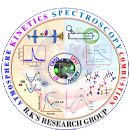Cl atom initiated photo-oxidation of monochlorinated propanes to form the carbonyl compounds was investigated. Propionaldehyde and acetone were identified to be major products in the oxidation of 1-chloropropane and 2-chloropropane, respectively. The complete product analyses were carried out using gas chromatography–mass spectrometry (GC–MS) and gas chromatography–infrared spectroscopy (GC–IR) as analytical tools, and an appropriate oxidation mechanism was proposed on the basis of the product analyses. The temperature dependent rate coefficients for the reactions of Cl atoms with 1-chloropropane (1-CP) and 2-chloropropane (2-CP) were measured experimentally in the gas phase, using the relative rate method in the temperature range 268–363 K and at 1 atm pressure. Ethane, ethylene, and ethyl acetate were used as reference compounds. The obtained rate coefficients for the reactions of Cl atoms with 1-CP and 2-CP at room temperature (298 K) and at 1 atm pressure were (4.64 ± 0.70) × 10–11 and (2.57 ± 0.44) × 10–11 cm3 molecule–1 s–1, respectively. Furthermore, to complement our experimentally obtained results, computational calculations were performed for these reactions using canonical variational transition state theory (CVT) with small curvature tunneling (SCT) in combination with the CCSD/cc-pVDZ//MP2/6-31+G(d,p) level of theory. Detailed discussion on feasibility of the reactions, branching ratios, degradation mechanism, and atmospheric implications are discussed in this manuscript.
-
Call
-
E-mail
Journal Details
1. Cl Atom Initiated Photo-oxidation of Mono-chlorinated Propanes To Form Carbonyl Compounds: A Kinetic and Mechanistic Approach.
A. Kumar and B. Rajakumar J. Phys. Chem., , 723-74, 4
